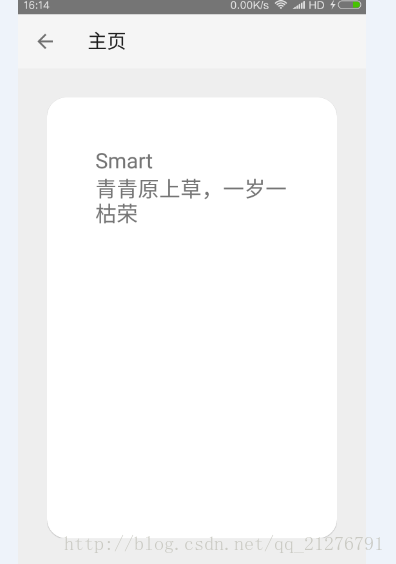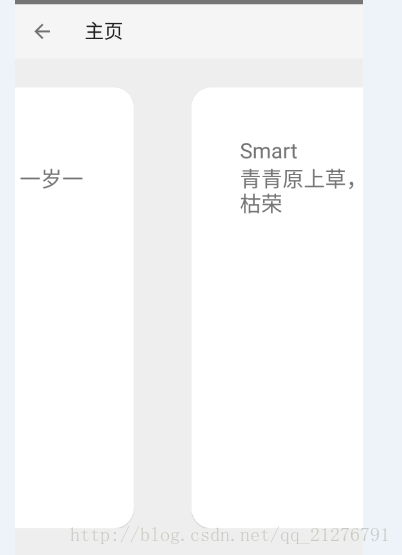现在来介绍两种控件RecyclerView和CardView,并通过实例将它们结合在一起实现一种横向卡片式滑动效果.
1.RecyclerView
RecyvlerView是android SDK 新增加的一种控件,也被官方推荐代替ListView来使用,因为其具有更好的灵活性和代替性。
2.CardView
CardView是安卓5.0推出的一种卡片式控件,内部封装了许多有用的方法来实现美观效果。
3.如何使用RecylerView和CardView在android studio中
在build.gradle中添加依赖再编辑即可
|
1
2
|
compile 'com.android.support:recyclerview-v7:25.+'compile 'com.android.support:cardview-v7:25 |
4.通过实例,使用两种控件实现横向卡片式滑动效果
建立main.xml布局文件,代码如下:
|
1
2
3
4
5
6
7
8
9
10
11
12
13
14
15
16
|
<?xml version="1.0" encoding="utf-8"?><LinearLayout xmlns:android="http://schemas.android.com/apk/res/android" android:orientation="vertical" android:layout_width="match_parent" android:layout_height="match_parent" xmlns:app="http://schemas.android.com/apk/res-auto"> <android.support.v7.widget.RecyclerView android:layout_width="match_parent" android:layout_height="match_parent" android:id="@+id/recycler_View" > </android.support.v7.widget.RecyclerView></LinearLayout> |
使用过ListView的同学应该知道还需要一个子布局来填充RecyclerView
以下为recyclerView_item.xml的代码:
|
1
2
3
4
5
6
7
8
9
10
11
12
13
14
15
16
17
18
19
20
21
22
23
24
25
26
27
28
29
30
31
32
33
34
35
36
37
38
39
40
41
42
43
44
45
46
47
48
49
50
51
52
|
<?xml version="1.0" encoding="utf-8"?><LinearLayout xmlns:android="http://schemas.android.com/apk/res/android" xmlns:app="http://schemas.android.com/apk/res-auto" android:orientation="vertical" android:layout_width="match_parent" android:layout_height="match_parent" android:id="@+id/recyclerview_item" android:padding="30dp" > <android.support.v7.widget.CardView android:layout_width="match_parent" android:layout_height="match_parent" android:orientation="vertical" app:contentPadding="50dp" app:cardCornerRadius="20dp" android:clickable="true" android:foreground="?android:attr/selectableItemBackground" app:cardElevation="@dimen/cardview_compat_inset_shadow" app:cardBackgroundColor="@color/cardview_light_background"> <LinearLayout android:layout_width="match_parent" android:layout_height="wrap_content"> <TextView android:id="@+id/tv1" android:layout_width="wrap_content" android:layout_height="wrap_content" android:layout_gravity="center" android:text="作者" android:textSize="22dp"/> </LinearLayout> <LinearLayout android:layout_width="match_parent" android:layout_height="114dp" > <TextView android:id="@+id/tv2" android:layout_width="wrap_content" android:layout_height="wrap_content" android:layout_gravity="center" android:text=" 锄禾日当午,汗滴禾下土" android:textSize="22dp"/> </LinearLayout> </android.support.v7.widget.CardView></LinearLayout> |
从代码中,我们会发现使用了CardView控件以及在控件中添加简易的两个TextView
现在来介绍CardView的一些常用属性,这也是现在卡片效果的关键所在
card_view:contentPadding 这个可以给你的内容加上padding属性
card_view:cardBackgroundColor这个可以改变cardview的背景
card_view:cardCornerRadius这个可以改变cardview圆角的大小
card_view:cardElevation这个比较难解释,CardView的Z轴阴影,被用来决定阴影的大小以及柔和度,以至于可以逼真的模拟出对于深度效果的描述。说白点可以理解为阴影的大小
andorid:foreground=”?android:attr/selectableItemBackground” 这个可以使CardView被点击后出现波纹效
通过以上常用属性可以使CardView出现各种不同的效果
现在回到Activity中来实现RecyclerView
跟ListView的一样,我们需要写一个适配器,代码如下:
|
1
2
3
4
5
6
7
8
9
10
11
12
13
14
15
16
17
18
19
20
21
22
23
24
25
26
27
28
29
30
31
32
33
34
35
36
37
38
39
40
|
public class recyclerViewadapter extends RecyclerView.Adapter { private List<DataBean> lists; private Context context; public recyclerViewadapter(List<DataBean> lists, Context context) { this.lists = lists; this.context = context; } class myholder extends RecyclerView.ViewHolder{ private TextView tv1,tv2; public myholder(View itemView) { super(itemView); tv1= (TextView) itemView.findViewById(R.id.tv1); tv2= (TextView) itemView.findViewById(R.id.tv2); } } @Override public RecyclerView.ViewHolder onCreateViewHolder(ViewGroup parent, int viewType) { myholder holder =new myholder(LayoutInflater.from(parent.getContext()).inflate(R.layout.recyclerview_item,parent,false)); return holder; } @Override public void onBindViewHolder(RecyclerView.ViewHolder holder, int position) { Log.d("TAG", "onBindViewHolder: "+lists.get(position).getAutor()); ((myholder)holder).tv1.setText(lists.get(position).getAutor()); ((myholder)holder).tv2.setText(lists.get(position).getContent()); } @Override public int getItemCount() { return lists.size(); }} |
写一个类继承RecyclerView.Adapter,重写RecyclerView.Adapter的三个重要方法 onBindViewHolder() getItemCount() 和 OncreateViewHolder()
|
1
2
3
|
OncreateViewHolder(): 创建新的View,被LayoutManager所调用OnBindViewHolder():将数据与界面进行绑定getItemCount() :返回数据的数量 |
在Activity中,代码如下:
|
1
2
3
4
5
6
7
8
9
10
11
12
13
14
15
16
17
18
19
20
21
22
23
24
25
26
27
28
29
30
31
32
33
34
35
36
37
38
39
40
41
42
43
44
45
46
47
48
49
50
51
52
53
54
55
56
57
58
|
public class Frament1 extends android.support.v4.app.Fragment{ private Toolbar toolbar1; private RecyclerView recycler_view; private TextView tv1,tv2; private View view; private List<DataBean> lists; @Override public void onAttach(Context context) { super.onAttach(context); } @Nullable @Override public View onCreateView(LayoutInflater inflater, @Nullable ViewGroup container, @Nullable Bundle savedInstanceState) { setHasOptionsMenu(true); view = inflater.inflate(R.layout.fragment1, container, false); initView(); initData(); LinearLayoutManager m=new LinearLayoutManager(getContext()); m.setOrientation(LinearLayoutManager.HORIZONTAL); recycler_view.setLayoutManager(m); recyclerViewadapter adapter=new recyclerViewadapter(lists,getContext()); recycler_view.setAdapter(adapter); return view; } @Override public void onResume() { super.onResume(); } private void initData() { lists=new ArrayList<>(); lists.add(new DataBean("Smart","青青原上草,一岁一枯荣")); lists.add(new DataBean("Smart","青青原上草,一岁一枯荣")); lists.add(new DataBean("Smart","青青原上草,一岁一枯荣")); lists.add(new DataBean("Smart","青青原上草,一岁一枯荣")); lists.add(new DataBean("Smart","青青原上草,一岁一枯荣")); lists.add(new DataBean("Smart","青青原上草,一岁一枯荣")); } private void initView() { recycler_view= (RecyclerView) view.findViewById(R.id.recycler_View); tv1= (TextView) view.findViewById(R.id.tv1); tv2= (TextView) view.findViewById(R.id.tv2); }} |
在代码中,我们获取LayoutManager对象,设置其方向为水平方向,并设置RecyclerView的LayoutManager
然后实例化adapter对象,传入上下文和假数据lists,并设置RecyclerView.adapater
|
1
2
3
4
5
|
LinearLayoutManager m=new LinearLayoutManager(getContext()); m.setOrientation(LinearLayoutManager.HORIZONTAL); recycler_view.setLayoutManager(m); recyclerViewadapter adapter=new recyclerViewadapter(lists,getContext()); recycler_view.setAdapter(adapter); |
到此基本步骤已经完成,运行程序。
以下为运行截图


以上就是本文的全部内容,希望对大家的学习有所帮助,也希望大家多多支持服务器之家。
原文链接:https://blog.csdn.net/qq_21276791/article/details/72992007

















